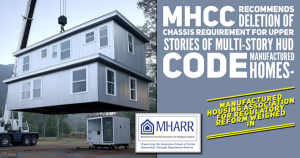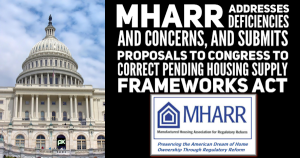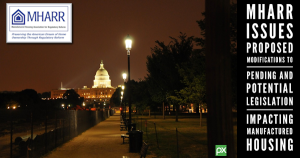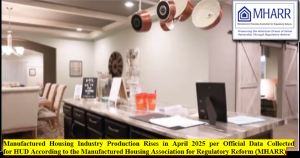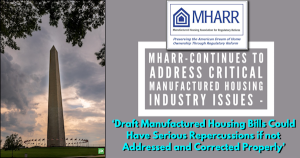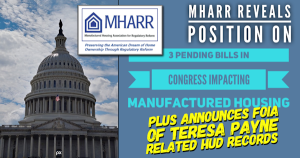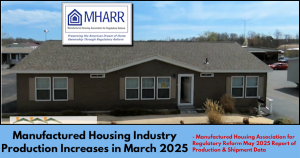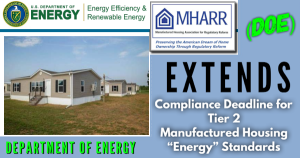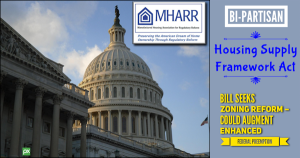MARK WEISS Addresses the Manufactured Housing Industry’s Twin Crises –an MHProNews Interview With MHARR President and CEO, Mark Weiss, J.D.
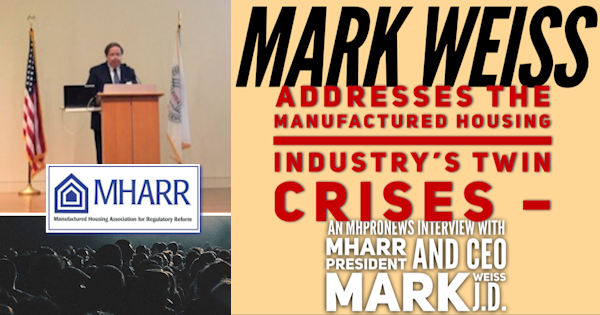
TO: HUD CODE MANUFACTURED HOUSING INDUSTRY MEMBERS
RE: MARK WEISS Addresses the Manufactured Housing Industry’s Twin Crises – an MHProNews Interview With MHARR President and CEO, Mark Weiss
Attached for your review and information is a reprint copy of a November 22, 2021 MHProNews interview with MHARR President and CEO, Mark Weiss.
The interview addresses two major issues that the manufactured housing industry and consumers of mainstream, affordable manufactured housing face, going forward.
Please feel free to share copies of this interview with others as you wish.
cc: MHARR General Distribution
Attachment
Manufactured Housing Association for Regulatory Reform (MHARR)
1331 Pennsylvania Ave N.W., Suite 512
Washington D.C. 20004
Phone: 202/783-4087
Fax: 202/783-4075
Email: MHARR@MHARRPUBLICATIONS.COM
Website: manufacturedhousingassociation.org
The original interview is found at on MHProNews at this link here and is reproduced here with permission.

The following is a exclusive new interview with attorney, manufactured housing industry veteran, Manufactured Housing Association for Regualtory Reform (MHARR) president and CEO, Marek Weiss. As a note for new and other readers, MHProNews conducted this Q&A style interview with follow up inquiries and dozens of others like it with industry professionals via email. So, the respondents – in this case Weiss – had ample time to carefully consider their answers to the questions and follow up inquiries that were posed.
Q1. The Biden Administration has been in office for nearly one year, now. What is your view of the Administration in relation to manufactured housing?
A1. Well, needless to say, there’s a major difference in outlook between the two. President Donald Trump was all about less regulation, smaller government and less government involvement in the day-to-day lives of Americans. Biden is all about bigger, more intrusive government and more government involvement in regulation.
Q2. What is your view of the Biden Administration’s specific approach to the HUD Code manufactured home industry?
A2. There are both good and bad elements. With regard to regulation, its bad. The DOE energy regulation is a specific example. That had been essentially withdrawn by the Trump Administration. Now it’s been brought back – “on steroids” if you will – and is being aggressively pursued. But there are positives, as well. For example, the Administration’s recognition of manufactured housing as a key source of affordable, non-subsidized housing. As has long been the case and as we at MHARR regularly point out, manufactured housing is usually supported by both sides of the political aisle, because we provide affordable housing and homeownership, and are also a major source of employment and factory jobs in areas where they are much-needed. And in return, the affordable manufactured home industry, traditionally, has only asked for parity and equality with other types of housing. In this regard, the Biden Administration talk has typically been good and ready-made for politically-useful public relations, but the results have not lived-up to the hype because there are major problems that have made the implementation of such promises virtually impossible. Meanwhile, the industry’s supposed post-production representation has gotten away with projecting this “happy face” to its constituents – until now.
Q3. That’s a loaded answer. Let’s break it down, because all too often that the industry gets unfiltered information out of Washington, D.C. regarding industry issues.
A3. That’s fine. We’re always getting inquiries from industry members looking for accurate and factual information.
Q4. Well, let’s start with the looming energy regulations matter that you mentioned. There is a big misunderstanding within the industry regarding the Department of Energy’s (DOE) proposed rule for manufactured housing. While its well-known within the industry that there is a law that requires this, given the fact that manufactured homes are already energy-efficient, many believe that the law should not be implemented or that the proposed regulation should not be as harsh and destructive. MHProNews has information that MHARR blocked this previously, but that it was effectively “rescued” by MHI and brought back through a phony “appliance”-based process. Can you elaborate?
A4. Its true that this was upended and stopped at one point and was apparently on the “back-burner” at DOE. It was revived though, in 2014, when part of the industry went along with and, in fact, asked for, a “negotiated rulemaking” process that never should have been used for this standard. Even worse, that process was totally contrived – a sham dominated by DOE allies with a pre-ordained result. That was a major error. By contrast, MHARR has been the only national industry organization to oppose DOE manufactured housing energy standards from the very start and has continued to vigorously oppose any such discriminatory and destructive mandates. If this rule, which is inherently discriminatory against manufactured housing and manufactured housing consumers, becomes a reality, the industry and consumers will regret that error for years to come – assuming the industry and, more specifically, the mainstream, affordable manufactured homes that the industry builds, can survive such an attack.
Q5. Didn’t the Trump Administration withdraw the 2016 proposed rule?
A5. Yes. They withdrew the proposed rule that DOE published as a “midnight regulation” near the end of the Obama Administration, in 2016. They then floated a multi-tiered approach in a 2018 Notice of Data Availability (NODA) but did not aggressively pursue the adoption of a final standard. Ultimately, though, DOE was sued by the activist Sierra Club, and wound up entering into a “consent order” that required them to publish a proposed standard in 2021 and will compel them to adopt a final standard in 2022. That, in turn, led to DOE’s August 26, 2021 proposed rule, which is in the notice and comment phase right now. And that is a terrible rule, based on high-cost requirements taken directly from the 2021 International Energy Conservation Code (IECC). So, going along to get along has bad consequences, in that it has led directly to where we are now. That in itself should be a lesson for the industry.
Q6. What do you mean, exactly?
A6. None of this should have ever happened. It should have been left “on ice” at DOE as it was in 2014.
Q7. So, what happens now, going forward?
A7. Now, it’s almost a foregone conclusion that DOE will adopt a standard of some kind in 2022 in order to comply with the court order and given both the proposed rule that we’ve seen and the “climate change” orientation of the current Administration, it is likely to be extremely harsh and costly. Combined with the failure of Fannie Mae and Freddie Mac to implement the “Duty to Serve” with respect to the chattel loans which finance the vast bulk of the industry’s new home production and GNMA’s “10-10” rule, which has collapsed FHA Title I lending, this could have a devastating impact on mainstream manufactured housing and most particularly the industry’s most affordable (currently) single-section homes.
Q8. In such a drastic situation, what would MHARR’s position be?
A8. Well, MHARR just had a Board of Directors meeting and it was the unanimous view of our members – consistent with the rest of the industry – that this standard must not be implemented in its current (proposed) form.
Q9. Could this include legal action?
A9. It should include legal action by and on behalf of the entire industry and consumers as well, if the industry wants to preserve and protect today’s mainstream, affordable manufactured housing after many decades of hard work to bring about its unique and successful evolution.
Q10. Thanks. Now going back to our previous discussion, please explain what you meant when you said, in your answer to Question 2, above, with respect to the Biden Administration and manufactured housing, that “the talk,” like that of previous administrations, “has … been good, but the results have not lived up to the hype…?”
A10. As I mentioned earlier, manufactured housing is the perfect solution to the nation’s affordable housing crisis, with no need whatsoever for costly, taxpayer-funded subsidization. As a result, there should be – and we’ve always advocated for – parity between manufactured housing and other types of homes. And to be fair, Congress and past administrations of both parties have tried to include manufactured housing in government housing programs. The problem has always been – and continues to be – that once these federal programs reach the state and local level, where they are actually to be implemented, there is a built-in aversion by governments at that level to the use and utilization of manufactured housing. This has been going on for years now, without any resolution, because the industry does not have an independent national post-production representative organization to fight for and actually advance and actually implement the full and equal inclusion of manufactured homes in such federal government housing largess.
Q11. We’ve heard about this before from industry people who say that manufactured homes are mentioned by name in certain government programs, but never get the actual benefit of those programs. Why is that?
A11. And that is a fair – and understandable – question that has confused many consumers and industry members as well. Quite simply, there is – and has been – a missing component in the representation of the industry to fight and advance these issues that affect our outstanding homes once they leave the factory. And because there is no independent post-production representation for the industry, the “inclusion” of manufactured homes in federal government programs has been used mostly as a public relations tool within the industry – a sort of “shell game,” if you will. The hard reality on the ground, though, has usually been that such inclusion never materializes, even in situations where it would be a natural fit, such as the redevelopment of disaster areas where relief (manufactured) homes are already in place, but are usually removed as re-development occurs. As you know, after passage of the 2000 reform law, MHARR realized quickly that to move today’s modern manufactured homes, built in accordance with that law, the industry would need to have a strong, independent national trade organization in order to promote and expand the utilization of these new homes, not only within the private sector, but also to full involvement and inclusion in government housing and home financing programs. But, as you know, that never happened, and the industry’s post-production sector continued without any real plan of action to assure that manufactured homes, even if nominally included in such federal programs, were part of the implementation of those programs at the state and local level. So now, with the Biden Administration, and with so much federal funding at stake, the industry is nominally included within the “text” of such programs once again, but left facing the same baseless implementation obstacles that have been allowed to fester for decades.
Q12. The last time the industry had a major post-production problem, i.e., the securitization of private consumer purchase-money loans, MHARR got involved and the Duty to Serve (DTS) emerged from the joint effort of MHARR and MHI to obtain an effective resolution. What is MHARR’s view of this funding and inclusion problem now, given the huge amounts of federal funding that the Biden Administration will be spending not only on housing in general, but specifically on affordable housing, which should put manufactured housing ahead of any other housing segment?
A12. As you know, MHARR tackles major industry problems methodically, by identifying the problem first and then aggressively attacking and resolving it for the benefit of the entire industry and consumers as well. With the Biden Administration planning to spend huge amounts on housing and community projects, the Association has decided to identify the specific reasons why manufactured housing is “included” in such programs in name only, without actual, concrete results on the ground.
Q13. Can you give us a general idea regarding MHARR’s plan for addressing this critical disconnect?
A13. I’m not at liberty to discuss the relevant details just yet, but the Association has begun work on a White Paper that will lay out the entire scope of the problem as well as suggested approaches for a positive resolution. On that point, its important to note that MHARR is not – and will not become – a post-production association. It can and will take steps to help guide the industry toward the actions that it believes are necessary but will not step directly into any role representing the industry’s post-production sector.
Q14. Thank you, this has been a most interesting discussion, which I hope will open the eyes of more industry members, consumers, nonprofit, and public officials.
A14. Thank you. The industry faces challenges as well as opportunities. Both have to be met and addressed vigorously and aggressively, with the firm conviction that the industry’s homes are the hands-down best solution to the nation’s affordable housing needs and that we have existing law on our side.
We value the important work MHProNews and your sister site [MHLivingNews] have done in recent years in uncovering and exposing the disconnects between the claims made by some in the industry vs. the often troubling realities. You’ve rightly said the industry should be soaring instead of snoring during an affordable housing crisis. The big difference between manufactured hone industry potential vs the industry’s reality is one of several reasons MHARR fights unjust regulations. We applaud your publications’ contributions in that effort. That may be why your readership is so broad. ##
TO: HUD CODE MANUFACTURED HOUSING INDUSTRY MEMBERS
RE: MARK WEISS Addresses the Manufactured Housing Industry’s Twin Crises – an MHProNews Interview With MHARR President and CEO, Mark Weiss
Attached for your review and information is a reprint copy of a November 22, 2021 MHProNews interview with MHARR President and CEO, Mark Weiss.
The interview addresses two major issues that the manufactured housing industry and consumers of mainstream, affordable manufactured housing face, going forward.
Please feel free to share copies of this interview with others as you wish.
cc: MHARR General Distribution
Attachment
Manufactured Housing Association for Regulatory Reform (MHARR)
1331 Pennsylvania Ave N.W., Suite 512
Washington D.C. 20004
Phone: 202/783-4087
Fax: 202/783-4075
Email: MHARR@MHARRPUBLICATIONS.COM
Website: manufacturedhousingassociation.org
The original interview is found at on MHProNews at this link here and is reproduced here with permission.
The headline says it all. The following is a exclusive new interview with attorney, manufactured housing industry veteran, Manufactured Housing Association for Regualtory Reform (MHARR) president and CEO, Marek Weiss. As a note for new and other readers, MHProNews conducted this Q&A style interview with follow up inquiries and dozens of others like it with industry professionals via email. So, the respondents – in this case Weiss – had ample time to carefully consider their answers to the questions and follow up inquiries that were posed.

The following is a exclusive new interview with attorney, manufactured housing industry veteran, Manufactured Housing Association for Regualtory Reform (MHARR) president and CEO, Marek Weiss. As a note for new and other readers, MHProNews conducted this Q&A style interview with follow up inquiries and dozens of others like it with industry professionals via email. So, the respondents – in this case Weiss – had ample time to carefully consider their answers to the questions and follow up inquiries that were posed.
Q1. The Biden Administration has been in office for nearly one year, now. What is your view of the Administration in relation to manufactured housing?
A1. Well, needless to say, there’s a major difference in outlook between the two. President Donald Trump was all about less regulation, smaller government and less government involvement in the day-to-day lives of Americans. Biden is all about bigger, more intrusive government and more government involvement in regulation.
Q2. What is your view of the Biden Administration’s specific approach to the HUD Code manufactured home industry?
A2. There are both good and bad elements. With regard to regulation, its bad. The DOE energy regulation is a specific example. That had been essentially withdrawn by the Trump Administration. Now it’s been brought back – “on steroids” if you will – and is being aggressively pursued. But there are positives, as well. For example, the Administration’s recognition of manufactured housing as a key source of affordable, non-subsidized housing. As has long been the case and as we at MHARR regularly point out, manufactured housing is usually supported by both sides of the political aisle, because we provide affordable housing and homeownership, and are also a major source of employment and factory jobs in areas where they are much-needed. And in return, the affordable manufactured home industry, traditionally, has only asked for parity and equality with other types of housing. In this regard, the Biden Administration talk has typically been good and ready-made for politically-useful public relations, but the results have not lived-up to the hype because there are major problems that have made the implementation of such promises virtually impossible. Meanwhile, the industry’s supposed post-production representation has gotten away with projecting this “happy face” to its constituents – until now.
Q3. That’s a loaded answer. Let’s break it down, because all too often that the industry gets unfiltered information out of Washington, D.C. regarding industry issues.
A3. That’s fine. We’re always getting inquiries from industry members looking for accurate and factual information.
Q4. Well, let’s start with the looming energy regulations matter that you mentioned. There is a big misunderstanding within the industry regarding the Department of Energy’s (DOE) proposed rule for manufactured housing. While its well-known within the industry that there is a law that requires this, given the fact that manufactured homes are already energy-efficient, many believe that the law should not be implemented or that the proposed regulation should not be as harsh and destructive. MHProNews has information that MHARR blocked this previously, but that it was effectively “rescued” by MHI and brought back through a phony “appliance”-based process. Can you elaborate?
A4. Its true that this was upended and stopped at one point and was apparently on the “back-burner” at DOE. It was revived though, in 2014, when part of the industry went along with and, in fact, asked for, a “negotiated rulemaking” process that never should have been used for this standard. Even worse, that process was totally contrived – a sham dominated by DOE allies with a pre-ordained result. That was a major error. By contrast, MHARR has been the only national industry organization to oppose DOE manufactured housing energy standards from the very start and has continued to vigorously oppose any such discriminatory and destructive mandates. If this rule, which is inherently discriminatory against manufactured housing and manufactured housing consumers, becomes a reality, the industry and consumers will regret that error for years to come – assuming the industry and, more specifically, the mainstream, affordable manufactured homes that the industry builds, can survive such an attack.
Q5. Didn’t the Trump Administration withdraw the 2016 proposed rule?
A5. Yes. They withdrew the proposed rule that DOE published as a “midnight regulation” near the end of the Obama Administration, in 2016. They then floated a multi-tiered approach in a 2018 Notice of Data Availability (NODA) but did not aggressively pursue the adoption of a final standard. Ultimately, though, DOE was sued by the activist Sierra Club, and wound up entering into a “consent order” that required them to publish a proposed standard in 2021 and will compel them to adopt a final standard in 2022. That, in turn, led to DOE’s August 26, 2021 proposed rule, which is in the notice and comment phase right now. And that is a terrible rule, based on high-cost requirements taken directly from the 2021 International Energy Conservation Code (IECC). So, going along to get along has bad consequences, in that it has led directly to where we are now. That in itself should be a lesson for the industry.
Q6. What do you mean, exactly?
A6. None of this should have ever happened. It should have been left “on ice” at DOE as it was in 2014.
Q7. So, what happens now, going forward?
A7. Now, it’s almost a foregone conclusion that DOE will adopt a standard of some kind in 2022 in order to comply with the court order and given both the proposed rule that we’ve seen and the “climate change” orientation of the current Administration, it is likely to be extremely harsh and costly. Combined with the failure of Fannie Mae and Freddie Mac to implement the “Duty to Serve” with respect to the chattel loans which finance the vast bulk of the industry’s new home production and GNMA’s “10-10” rule, which has collapsed FHA Title I lending, this could have a devastating impact on mainstream manufactured housing and most particularly the industry’s most affordable (currently) single-section homes.
Q8. In such a drastic situation, what would MHARR’s position be?
A8. Well, MHARR just had a Board of Directors meeting and it was the unanimous view of our members – consistent with the rest of the industry – that this standard must not be implemented in its current (proposed) form.
Q9. Could this include legal action?
A9. It should include legal action by and on behalf of the entire industry and consumers as well, if the industry wants to preserve and protect today’s mainstream, affordable manufactured housing after many decades of hard work to bring about its unique and successful evolution.
Q10. Thanks. Now going back to our previous discussion, please explain what you meant when you said, in your answer to Question 2, above, with respect to the Biden Administration and manufactured housing, that “the talk,” like that of previous administrations, “has … been good, but the results have not lived up to the hype…?”
A10. As I mentioned earlier, manufactured housing is the perfect solution to the nation’s affordable housing crisis, with no need whatsoever for costly, taxpayer-funded subsidization. As a result, there should be – and we’ve always advocated for – parity between manufactured housing and other types of homes. And to be fair, Congress and past administrations of both parties have tried to include manufactured housing in government housing programs. The problem has always been – and continues to be – that once these federal programs reach the state and local level, where they are actually to be implemented, there is a built-in aversion by governments at that level to the use and utilization of manufactured housing. This has been going on for years now, without any resolution, because the industry does not have an independent national post-production representative organization to fight for and actually advance and actually implement the full and equal inclusion of manufactured homes in such federal government housing largess.
Q11. We’ve heard about this before from industry people who say that manufactured homes are mentioned by name in certain government programs, but never get the actual benefit of those programs. Why is that?
A11. And that is a fair – and understandable – question that has confused many consumers and industry members as well. Quite simply, there is – and has been – a missing component in the representation of the industry to fight and advance these issues that affect our outstanding homes once they leave the factory. And because there is no independent post-production representation for the industry, the “inclusion” of manufactured homes in federal government programs has been used mostly as a public relations tool within the industry – a sort of “shell game,” if you will. The hard reality on the ground, though, has usually been that such inclusion never materializes, even in situations where it would be a natural fit, such as the redevelopment of disaster areas where relief (manufactured) homes are already in place, but are usually removed as re-development occurs. As you know, after passage of the 2000 reform law, MHARR realized quickly that to move today’s modern manufactured homes, built in accordance with that law, the industry would need to have a strong, independent national trade organization in order to promote and expand the utilization of these new homes, not only within the private sector, but also to full involvement and inclusion in government housing and home financing programs. But, as you know, that never happened, and the industry’s post-production sector continued without any real plan of action to assure that manufactured homes, even if nominally included in such federal programs, were part of the implementation of those programs at the state and local level. So now, with the Biden Administration, and with so much federal funding at stake, the industry is nominally included within the “text” of such programs once again, but left facing the same baseless implementation obstacles that have been allowed to fester for decades.
Q12. The last time the industry had a major post-production problem, i.e., the securitization of private consumer purchase-money loans, MHARR got involved and the Duty to Serve (DTS) emerged from the joint effort of MHARR and MHI to obtain an effective resolution. What is MHARR’s view of this funding and inclusion problem now, given the huge amounts of federal funding that the Biden Administration will be spending not only on housing in general, but specifically on affordable housing, which should put manufactured housing ahead of any other housing segment?
A12. As you know, MHARR tackles major industry problems methodically, by identifying the problem first and then aggressively attacking and resolving it for the benefit of the entire industry and consumers as well. With the Biden Administration planning to spend huge amounts on housing and community projects, the Association has decided to identify the specific reasons why manufactured housing is “included” in such programs in name only, without actual, concrete results on the ground.
Q13. Can you give us a general idea regarding MHARR’s plan for addressing this critical disconnect?
A13. I’m not at liberty to discuss the relevant details just yet, but the Association has begun work on a White Paper that will lay out the entire scope of the problem as well as suggested approaches for a positive resolution. On that point, its important to note that MHARR is not – and will not become – a post-production association. It can and will take steps to help guide the industry toward the actions that it believes are necessary but will not step directly into any role representing the industry’s post-production sector.
Q14. Thank you, this has been a most interesting discussion, which I hope will open the eyes of more industry members, consumers, nonprofit, and public officials.
A14. Thank you. The industry faces challenges as well as opportunities. Both have to be met and addressed vigorously and aggressively, with the firm conviction that the industry’s homes are the hands-down best solution to the nation’s affordable housing needs and that we have existing law on our side.
We value the important work MHProNews and your sister site [MHLivingNews] have done in recent years in uncovering and exposing the disconnects between the claims made by some in the industry vs. the often troubling realities. You’ve rightly said the industry should be soaring instead of snoring during an affordable housing crisis. The big difference between manufactured hone industry potential vs the industry’s reality is one of several reasons MHARR fights unjust regulations. We applaud your publications’ contributions in that effort. That may be why your readership is so broad. ##



